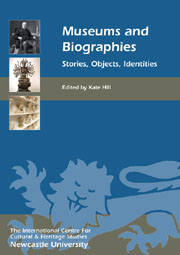Book contents
- Frontmatter
- Contents
- List of Illustrations
- Introduction: Museums and Biographies – Telling Stories about People, Things and Relationships
- INDIVIDUAL BIOGRAPHY AND MUSEUM HISTORY
- 1 A Show of Generosity: Donations and the Intimacy of Display in the ‘Cabinet des médailles et antiques’ in Paris from 1830 to 1930
- 2 Introducing Mr Moderna Museet: Pontus Hultén and Sweden's Museum of Modern Art
- 3 Sydney Pavière and the Harris Museum and Art Gallery, Preston
- PROBLEMATISING INDIVIDUALS' BIOGRAPHIES
- INSTITUTIONAL BIOGRAPHIES
- OBJECT BIOGRAPHIES
- MUSEUMS AS BIOGRAPHY
- MUSEUMS AS AUTOBIOGRAPHY
- Endpiece: The Homunculus and the Pantograph, or Narcissus at the Met
- List of Contributors
- Index
3 - Sydney Pavière and the Harris Museum and Art Gallery, Preston
from INDIVIDUAL BIOGRAPHY AND MUSEUM HISTORY
Published online by Cambridge University Press: 05 February 2013
- Frontmatter
- Contents
- List of Illustrations
- Introduction: Museums and Biographies – Telling Stories about People, Things and Relationships
- INDIVIDUAL BIOGRAPHY AND MUSEUM HISTORY
- 1 A Show of Generosity: Donations and the Intimacy of Display in the ‘Cabinet des médailles et antiques’ in Paris from 1830 to 1930
- 2 Introducing Mr Moderna Museet: Pontus Hultén and Sweden's Museum of Modern Art
- 3 Sydney Pavière and the Harris Museum and Art Gallery, Preston
- PROBLEMATISING INDIVIDUALS' BIOGRAPHIES
- INSTITUTIONAL BIOGRAPHIES
- OBJECT BIOGRAPHIES
- MUSEUMS AS BIOGRAPHY
- MUSEUMS AS AUTOBIOGRAPHY
- Endpiece: The Homunculus and the Pantograph, or Narcissus at the Met
- List of Contributors
- Index
Summary
After 33 years of service, Sydney Pavière, white-haired and three years beyond the usual retirement age, stood before the Art Gallery Committee. He was there to announce his retirement from his post of art director and curator at the Harris Museum and Art Gallery. Addressing the committee, and speaking with obvious affection and sincerity, he said: ‘Gentlemen we have built a monument here. Please see that nothing is done to despoil it’ (Rushton 1959, 33).
It sometimes happens that the character, as well as the actions, of a particular curator casts a long shadow within a museum or gallery. In the second quarter of the 20th century, a number of curators brought foresight, good judgement and individualism to their work. Lawrence Haward, appointed director of Manchester Art Gallery in 1914; Vincent Galloway, appointed curator at the Ferens Art Gallery in Hull in 1929; and Peter Floud, who joined the V&A's circulation department in 1935, emerged to establish unique and strong identities for their museums and collections. It is possible to identify an emergence of curators in national and provincial museums, working in the interwar and immediate post-war period, who had a breadth of vision for the collections in their care. Pioneering young creative museum and gallery curators, sometimes with an artistic background (both Galloway and Pavière were painters), were playing an important role not only within their institutions but also in the continuing development of the museum profession, a factor for those curators wishing to exercise within their role a significant degree of individual agency.
- Type
- Chapter
- Information
- Museums and BiographiesStories, Objects, Identities, pp. 45 - 58Publisher: Boydell & BrewerPrint publication year: 2012



